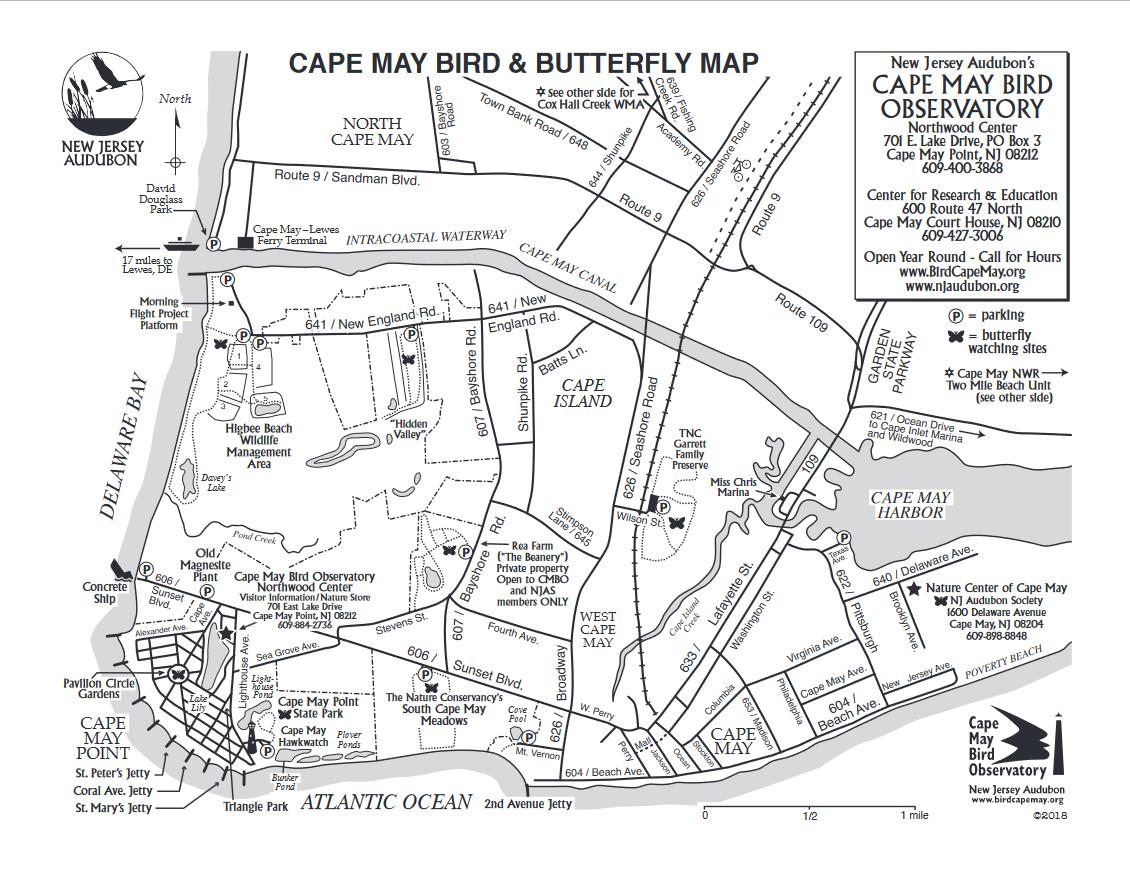Cape Island--CMPSP--Hawkwatch Platform
Cape Island--CMPSP--Hawkwatch Platform
Cape May Point, New Jersey 08212
Official WebsiteCape May Point Official Website
Cape May Bird Observatory map
Cape May Point State Park Official Website
Cape May Point State Park map
Birds of Interest
Cape May’s regular raptors include Accipiters like the Sharp-shinned Hawk, Cooper’s Hawk, and Northern Goshawk; Buteos like Red-tailed Hawk, Red-shouldered Hawk, Broad-winged Hawk, Rough-legged Hawk and Swainson’s Hawk; Falcons like the Peregrine, Merlin and American Kestrel. Also seen regularly are Osprey, Northern Harrier, Bald Eagle, Golden Eagle, as well as Turkey Vulture and Black Vulture.
Some of these species (like Sharp-shinned Hawk, and Red- tailed Hawk) are common, even abundant, and their migration period is long. Observers can expect to see these species almost every day. Other species like the Swainson’s Hawk and Rough-legged Hawk are locally uncommon, seen only a few times a season, or have a migration period that is very restricted. What species you will see depends upon the time of your visit and the weather conditions you experience.
Unlike many other hawk migration sites, hawks are almost always visible from the Hawk Watch Platform during the count period (September - November). But what hawk watchers live for, are those days when weather conditions cause hawks to move in great numbers. These “flights” are caused by the passage of a cold front—a high pressure cell moving into the region from the north or west. The falling temperatures stimulate birds to migrate and the associated north to northwest winds ferry birds to the Atlantic Coast. Being reluctant to cross open water, many hawks concentrate along the coast, following its contours, south and west, until they reach Cape May.
In general, the smaller hawks, like the Kestrel and Sharp-shinned Hawk, are most common on the first day following the passage of a cold front. The larger, soaring birds, like the Eagles and Buteos, are more abundant on the second (or third) day of sustained north to northwest winds.
Northeast winds can also produce large flights, particularly falcons (which are not shy about crossing water and prone to migrate offshore). Southerly or southwesterly winds make for business-as-usual migrations, which means only several hundred birds a day during the peak of the migratory period, instead of several thousand birds.
About this Location
Cape May is a peninsula, an extension of the New Jersey coastal plain bordered on the west by Delaware Bay and to the east by the Atlantic Ocean. This makes Cape May a natural funnel, catching and directing southbound birds to the peninsula’s terminus at Cape May Point.
It is a fundamental tenet of the natural world that predators remain less common than their prey. A hopeful observer could spend hours in prime Cooper’s Hawk or Merlin territory and never catch a glimpse. Only during migration, when birds of prey are concentrated at key geographic locations are they readily seen. Cape May, New Jersey is without a doubt, the finest vantage point in North America.
About Cape May Point
See all hotspots at Cape May Point
Situated at the southern-most tip of the Jersey Cape, Cape May Point is well known for its many natural attractions, serene beaches and historic sites. During spring and fall migration, this small Borough is home to more birds than residents.
Founded in 1875, Cape May Point was originally called Stites Beach and then Seagrove.
Cape May Point is a major migratory route along the Atlantic Flyway. Many sea/shore birds and songbirds migrate through this area in the spring. At the end of the summer, Dragonflies and Monarch Butterflies migrate through the area stopping briefly to gain their strength before continuing their journey across the Delaware Bay.
Cape May Point is part of the annual migration of the Horseshoe Crab along the Delaware Bay. Each year in late May, thousands of horseshoe crab come ashore to lay their eggs. These protein rich eggs are an important food source for Ruddy Turnstones, and Red Knots.
Cape May Point is considered the premier Hawk migration route of North America. In the fall hundreds of hawks are counted as they pass the narrow corridor of land along the Cape May peninsula heading south. This offers birdwatchers of all ages the opportunity to see these beautiful birds in flight as they soar across the fields and meadows, on their southward trek across the Delaware Bay.
About Cape May Point State Park
See all hotspots at Cape May Point State Park
Cape May Point State Park is one of North America's most popular sites for bird watching and a natural route for migratory birds.
Cape May Point State Park has 244 acres of freshwater meadows, ponds, forests, dunes, and beaches. Just a short bike ride from historic Cape May, the park is best known for the famous Cape May Lighthouse, a World War II gun battery and fire control tower, world-renowned fall bird migration, monarch butterflies, and Cape May diamonds. Thousands of visitors enjoy beach walking, hiking, birding, and fishing annually. Nature programs are available. The lighthouse and fire control tower are open seasonally and are administered by the Mid-Atlantic Center for the Arts and Humanities.
Features
Restrooms on site
Wheelchair accessible trail
Entrance fee
Content from Official Website, Cape May Point Official Website, Cape May Point State Park Official Website, and James Lukenda
Last updated March 13, 2024
 Cape May Bird Observatory
Cape May Bird Observatory